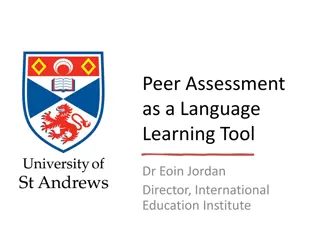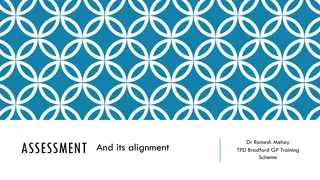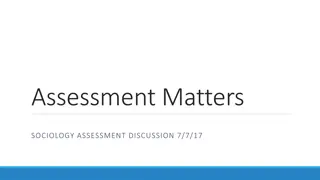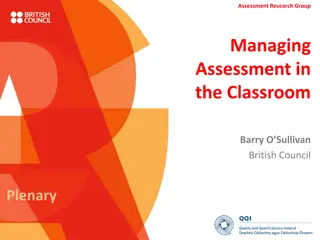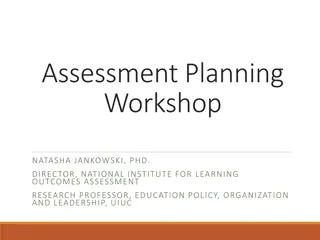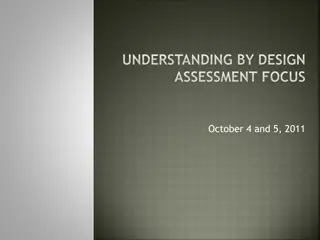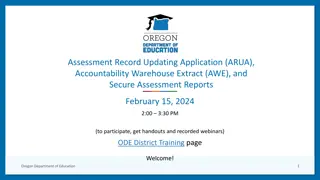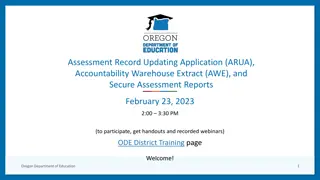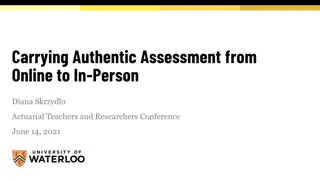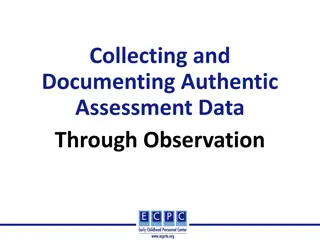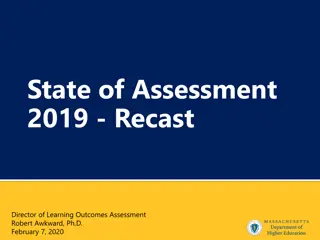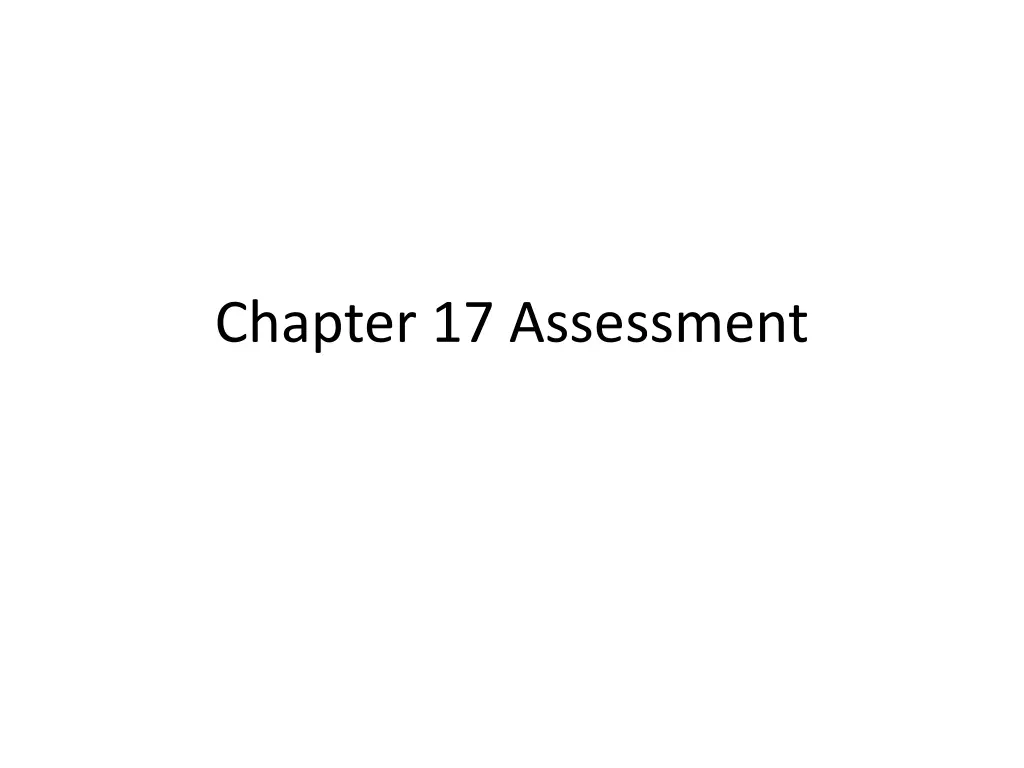
Understanding GST Assessment Process
Assessment in GST involves determining a taxpayer's tax liability through self-assessment, provisional assessment, and more. Learn about different types of assessment under GST law, such as self-assessment and scrutiny of returns. Find out the process for provisional assessment and how a registered dealer can request it.
Download Presentation

Please find below an Image/Link to download the presentation.
The content on the website is provided AS IS for your information and personal use only. It may not be sold, licensed, or shared on other websites without obtaining consent from the author. If you encounter any issues during the download, it is possible that the publisher has removed the file from their server.
You are allowed to download the files provided on this website for personal or commercial use, subject to the condition that they are used lawfully. All files are the property of their respective owners.
The content on the website is provided AS IS for your information and personal use only. It may not be sold, licensed, or shared on other websites without obtaining consent from the author.
E N D
Presentation Transcript
Assessment means determination of tax liability and includes self-assessment, re-assessment, provisional assessment, summary assessment and best judgment assessment. Assessment is the process of determination of the tax liability of a taxpayer. There are different ways to determine tax liability under the GST law. GST Assessment is required to be done to establish the tax liability of an assesses. Taxation Laws lay down a process of assessment, i.e. a way to figure out exactly how much tax should be paid.
Types of Assessment under GST: The type of assessment are provided under GST Law are as follows: a) Self Assessment b) Provisional Assessment c) Scrutiny of Returns d) Assessment of Non-Filer of Returns e) Assessment of unregistered persons f) Summary assessment in special cases
1. Self Assessment: Self Assessment as the name suggests is a process whereby a person first assesses, tax payable by him, pays the tax and then files the return furnishing the details of how he has arrived at the tax payable by him. The assessment as made by the registered person would be treated as final.
2. Provisional Assessment A registered dealer can request the officer for provisional assessment if he is unable to determine the value of goods or rate of tax. The proper officer can allow the assesses to pay tax on a provisional basis at a rate or a value specified by him. Situations demanding provisional assessment Provisional Assessment of a person would be conducted on the request of the registered person in either of the two circumstances: He is unable to determine the value of the goods or services or both. He is unable to determine the rate of tax applicable on the goods or services or both
Procedure for provisional assessment (filing of application) 1. Filing of application:- Every registered person requesting for payment of tax on a provisional basis in accordance with the provisions of sub-section (1) of section 60 shall furnish an application along with the documents in support of his request, electronically in FORM GST ASMT-01 on the common portal, either directly or through a Facilitation Centre notified by the Commissioner. 2. Issue of Notice by officer & reply by applicant:- The proper officer may, on receipt of the application under sub-rule (1), issue a notice in FORM GST ASMT-02 requiring the registered person to furnish additional information or documents in support of his request and the applicant shall file a reply to the notice in FORM GST ASMT 03, and may appear in person before the said officer if he so desires.
3. Issue of order by officer:- The proper officer shall issue an order in FORM GST ASMT-04 allowing the payment of tax on a provisional basis indicating the value or the rate or both on the basis of which the assessment is to be allowed on a provisional basis and the amount for which the bond is to be executed and security to be furnished not exceeding twenty five per cent. of the amount covered under the bond. 4. Execution of bond:- The registered person shall execute a bond in accordance with the provisions of sub-section (2) of section 60 in FORM GST ASMT-05 along with a security in the form of a bank guarantee for an amount as determined under sub-rule (3): Provided that a bond furnished to the proper officer under the State Goods and Services Tax Act or Integrated Goods and Services Tax Act shall be deemed to be a bond furnished under the provisions of the Act and the rules made there under.
5. Calling for information:- The proper officer shall issue a notice in FORM GST ASMT-06, calling for information and records required for finalization of assessment. 6. Final assessment:- The proper officer shall issue a final assessment order, specifying the amount payable by the registered person or the amount refundable, if any , in Form GST ASMT- 07. 7. Release of security:- The proper officer shall release the security furnished under sub-rule (4), after ensuring that the applicant has paid the amount specified in sub-rule (5) and issue an order in FORM GST ASMT 09 within a period of seven working days from the date of the receipt of the application under sub-rule (6).
Finalization of provisional assessment:- The final assessment order has to be passed by the proper officer within a period six months from the date of the communication of the order of provisional assessment. On sufficient cause being shown and for reasons to be recorded in writing, the time limit for finalization of provisional assessment can be, extended by the Joint Commissioner or Additional Commissioner for a further period not exceeding six months and by the Commissioner for such further period not exceeding four years.
Tax liability as per final assessment a) Same tax liability:- where the tax liability as per the final assessment is equal to the liability under provisional assessment, then the tax is neither payable nor refundable. b) Higher tax liability:- if the tax liability under final assessment is higher, then the tax becomes payable to the difference between the two assessments. The registered person shall be liable to pay interest on tax due but not paid, at the rate specified under sec. 50(1) from the date the tax was due to be paid originally till the date of actual payment.
(c) Less tax liability:- where the tax liability as per the final assessment is less than in provisional assessment i.e. Tax becomes refundable consequent to the order of final assessment, the registered person shall be paid interest at the rate specified under sec.56 from the date immediately after the expiry of 60 days from the date of receipt of application in accordance with the provisions of sec. 54(1) till the date of refund of such tax. It means, in case any tax amount becomes refundable subsequent to finalization of the provisional assessment, then interest at the specified rate will be payable to the supplier.
Scrutiny return The foll. Are the provisions: 1. Scrutiny by proper officer:- The proper officer may scrutinize the return and related particulars furnished by the taxable person to verify the correctness of the return in such manner as may be prescribed. The proper officer shall inform the taxable person of the discrepancies noticed, if any, after such scrutiny in such manner as may be prescribed and seek his explanation thereto. 2. Communication to registered person:- In case the explanation is found acceptable, the taxable person shall be informed accordingly and no further action shall be taken in this regard.
3. Action by proper officer:- In case no satisfactory explanation is furnished within a period of thirty days of being informed by the proper officer or such further period as may be permitted by him or where the taxable person, after accepting the discrepancies, fails to take the corrective measure in his return for the month in which the discrepancy is accepted, the proper officer may take recourse to any of the foll. Provisions, namely: a) Proceed to conduct audit b) Direct the conduct of a special audit is to be conducted by a C.A. Or Cost accountant nominated for this purpose by the commissioner; or c) Undertaken procedure of inspection, search and seizure or d) Initiate proceeding for determination of tax and other dues of this act.
Assessment of non-filers of returns: (1) Where a registered taxable person fails to furnish the return (monthly /quarterly) and (2) a notice under section 46, the proper officer may, after allowing a period of fifteen days from the date of service of the notice, proceed to assess the tax liability of the said person to the best of his judgement taking into account all the relevant material which is available or which he has gathered and issue an assessment order within the time limit specified in sub-section (7) of section 51A or sub- section (7) of section 51B, as the case may be. (3) Where the taxable person furnishes a valid return within thirty days of the service of the assessment order under sub-section (1), the said assessment order shall be deemed to have been withdrawn.
the best judgment of the Assessing officer. Within 5 years from the due date for filing of the annual return of the relevant year.
Assessment of unregistered persons This assessment is done when a taxable person fails to obtain registration even though he is liable to do so. The officer will assess the tax liability of such persons to the best of his judgement. The taxable person will receive a show cause notice and an opportunity of being heard.
This Section is applicable to unregistered persons i.e., persons who are liable to obtain registration This provision also covers the cases whose registration was cancelled as per section 29 (2) claiming of the GST Act. Section 29(2) of the Act covers 5 instances as follows: (a) A person who contravenes the provisions of this Act or Rules made there under; (b) A composition person who fails to furnish returns for 3 consecutive tax periods. (c) A person other than composition person who fails to furnish returns for 6 consecutive months. (d) A person who has sought voluntary registration but has failed to commence business within 6 months. (e) Where registration has been obtained by way of fraud, wilful misstatement or suppression of facts.
Issue of Notice Notice has to be issued in FORM GST ASMT-14 by the proper officer. The notice would contain the grounds on which the assessment is proposed to be made on best judgment basis. The registered person is allowed a time of 15 days to furnish his reply, if any. After considering the said explanation, the order has to be passed in FORM GST ASMT- 15. Time limit for Assessment order The proper officer has to pass an assessment order u/s 63 within a period of five years from the due date for filing the annual return for the year to which such tax unpaid relates to.
Summary Assessment: The summary assessments can be initiated to protect the interest of revenue with the previous permission of additional commissioner/joint commissioner when: 1. The proper officer has evidence that a taxable person has incurred a liability to pay tax under the act, and 2. The proper officer has sufficient grounds to believe that delay in passing an assessment order may adversely affect the interest of revenue.
Withdrawal of assessment order The summary assessment order may be withdrawn by Additional Commissioner or Joint Commissioner:- a. On an application made by the taxable person within thirty days from the date of receipt of order passed under sub-section or b. on his own motion, Deemed taxable person in case of supply of goods where the taxable person to whom the liability pertains is not ascertainable and such liability pertains to supply of goods, the person in charge of such goods shall be deemed to be the taxable person liable to be assessed and liable to pay tax and any other amount due under this section.


